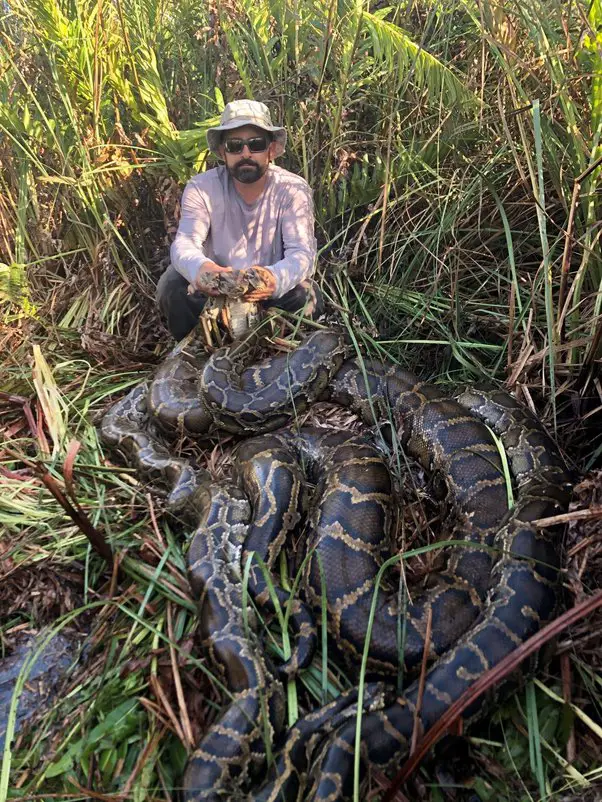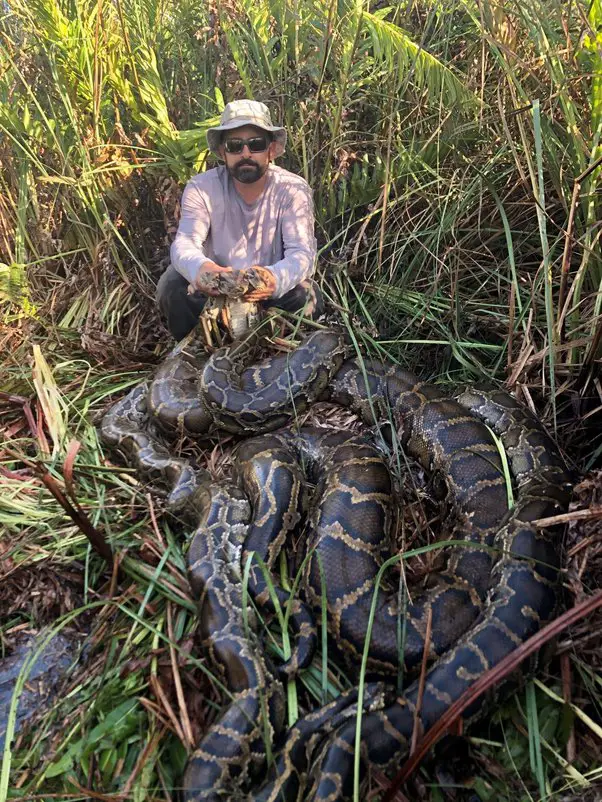Burmese pythons are one of the largest snakes in the world, but do they have any predators? These massive snakes can grow up to 23 feet long and weigh over 200 pounds, making them a formidable force in the animal kingdom. However, even the mightiest of creatures have their weaknesses, and the Burmese python is no exception.
In this article, we will explore the world of the Burmese python and its potential predators. From natural predators to human threats, we will delve into the dangers facing these impressive snakes. So, grab your snake boots and let’s dive into the fascinating world of the Burmese python!
Yes, the Burmese Python has several predators in its natural habitat. These include large birds of prey, such as eagles and hawks, as well as other snakes, such as the king cobra. Humans are also a threat to Burmese Pythons, as they are often hunted for their skin and meat.

Does the Burmese Python Have Any Predators?
Are you curious about the predators of the Burmese python? The Burmese python is a massive snake that is native to Southeast Asia. It is a highly adaptable species that can thrive in a variety of environments. But despite its size and strength, are there any predators that can take down this formidable snake?
Natural Predators of Burmese Pythons
In the wild, Burmese pythons face a variety of natural predators. The most significant of these predators are crocodiles, alligators, and large birds of prey. Young pythons are also at risk of predation by mammals such as foxes, wild dogs, and even other snakes.
These natural predators pose a significant threat to the Burmese python population, especially in areas where their habitat overlaps with that of crocodiles and alligators. In addition, the Burmese python is facing threats from habitat loss and human hunting, which further reduces their population.
Benefits of Natural Predators on Burmese Python Population
While natural predators may pose a threat to the Burmese python population, they also play a vital role in regulating their numbers. Without natural predators, the Burmese python population could become too large, leading to competition for resources and potential environmental damage.
Vs Human Hunting
On the other hand, human hunting has a much more significant impact on the Burmese python population than natural predators. Humans hunt the python for its skin, which is highly valued in the fashion industry. In addition, the Burmese python is also hunted for its meat, which is considered a delicacy in some cultures.
Invasive Predators of Burmese Pythons
Invasive predators are another significant threat to the Burmese python population. Invasive species such as the Nile monitor lizard and the Argentine black and white tegu have been introduced into the Burmese python’s habitat and are known to prey on their eggs and hatchlings.
Impact of Invasive Predators on Burmese Python Population
The introduction of invasive predators has had a significant impact on the Burmese python population. These predators have increased the mortality rate of Burmese python eggs and hatchlings, leading to a decline in their population.
Vs Natural Predators
Compared to natural predators, invasive predators pose a more significant threat to the Burmese python population. Invasive predators are not part of the natural ecosystem and have no natural predators themselves, which means they can quickly reproduce and spread, leading to a severe impact on the Burmese python population.
Conclusion
In conclusion, the Burmese python faces a variety of natural and invasive predators that pose a significant threat to their population. While natural predators play a vital role in regulating their numbers, human hunting and invasive predators have had a much more significant impact on their population. It is essential that we take steps to protect the Burmese python from these threats to ensure their continued survival in the wild.
| Natural Predators | Invasive Predators |
|---|---|
| Crocodiles | Nile Monitor Lizard |
| Alligators | Argentine Black and White Tegu |
| Large Birds of Prey | |
| Foxes | |
| Wild Dogs |
Frequently Asked Questions
Does the Burmese Python Have Any Predators?
The Burmese python, one of the largest snakes in the world, is a top predator in its ecosystem. However, that does not mean it is invincible. The Burmese python faces threats from several predators, including humans, alligators, and other large predators.
Humans are the biggest threat to the Burmese python. These snakes are often hunted for their skin, which is used to make various products, and for their meat, which is considered a delicacy in some cultures. In addition, habitat destruction and fragmentation caused by human activities have also negatively impacted the Burmese python population.
Alligators are another predator of the Burmese python. These two species share the same habitat in the southern United States, and sometimes compete for the same prey. While alligators are not known to actively hunt Burmese pythons, they may attack and kill them if they feel threatened.
How Does the Burmese Python Protect Itself?
The Burmese python has several ways to protect itself from predators. When threatened, the python will first try to escape by slithering away quickly. If that is not possible, it will try to defend itself by hissing loudly and striking at the predator with its sharp teeth.
Another defense mechanism of the Burmese python is its ability to camouflage itself. These snakes have a patterned skin that helps them blend into their environment, making it harder for predators to spot them. Additionally, the Burmese python will often lie still and wait for prey to come to it, rather than actively hunting. This behavior reduces the chances of attracting predators.
What Do Burmese Pythons Eat?
Burmese pythons are carnivorous and have a varied diet. They will eat any animal they can overpower, including rodents, birds, lizards, and other snakes. As they grow larger, they may also prey on larger animals such as deer, pigs, and even alligators.
Burmese pythons are ambush predators, meaning they wait for their prey to come to them. They will lie in wait for hours or even days, waiting for the perfect opportunity to strike. Once the python catches its prey, it will constrict it with its powerful muscles until the animal suffocates.
Where Do Burmese Pythons Live?
Burmese pythons are native to Southeast Asia but have been introduced to other parts of the world, including the southern United States. In their native range, they can be found in a variety of habitats, including forests, grasslands, and swamps.
In the United States, Burmese pythons have established populations in Florida, where they are considered an invasive species. They are found in the Everglades and other wetlands, where they thrive in the warm, humid climate. Their presence in the United States has had a negative impact on native species, and efforts are being made to control their population.
How Big Do Burmese Pythons Get?
Burmese pythons are one of the largest snakes in the world and can grow to be over 20 feet long. The average size for an adult Burmese python is between 12 and 18 feet long, although some individuals have been known to reach lengths of up to 23 feet.
Burmese pythons are also one of the heaviest snakes, with adults weighing between 100 and 200 pounds. Their large size makes them formidable predators, and they have few natural enemies. However, their size also makes them vulnerable to human activities such as hunting and habitat destruction.
The Species with Only One Natural Predator
In conclusion, the Burmese python is one of the largest snakes in the world, and it’s not uncommon to wonder if it has any natural predators. While it’s true that the Burmese python is an apex predator, it doesn’t mean that it’s invincible.
Despite its size and strength, the Burmese python has a few predators in the wild. One of its biggest predators is the human being, who has hunted the Burmese python for its meat, skin, and other body parts.
Another predator of the Burmese python is the alligator. While the Burmese python may be able to overpower smaller alligators, larger alligators have been known to prey on the snake.
In conclusion, while the Burmese python may be one of the most powerful predators in its ecosystem, it’s not invincible. The human being and the alligator are just a few of the predators that the Burmese python has to contend with in the wild.


